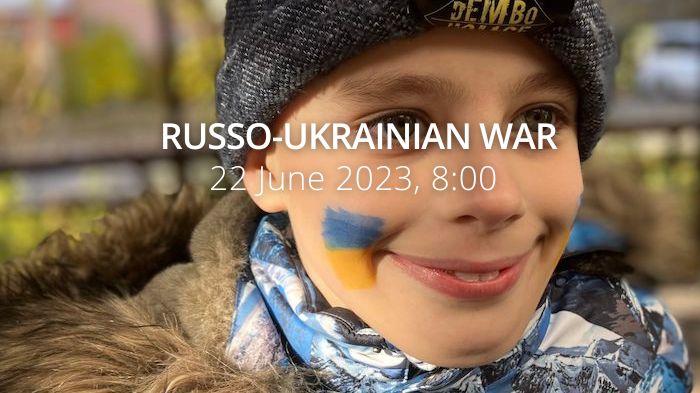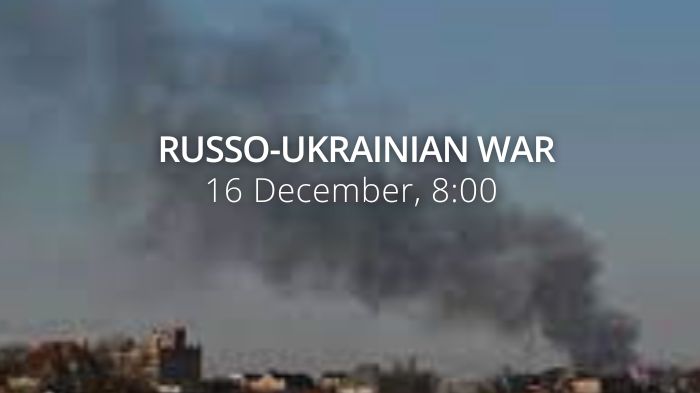The West commits billions to rebuild Ukraine. The Duma is responding to the international condemnation of Russia’s deportation of children from occupied Ukraine. IAEA says situation of ZNPP "extremely fragile."
Daily overview — Summary report, June 22
The General Staff’s operational update regarding the Russian invasion as of 18.00 pm, June 22, 2023 is in the dropdown menu below:
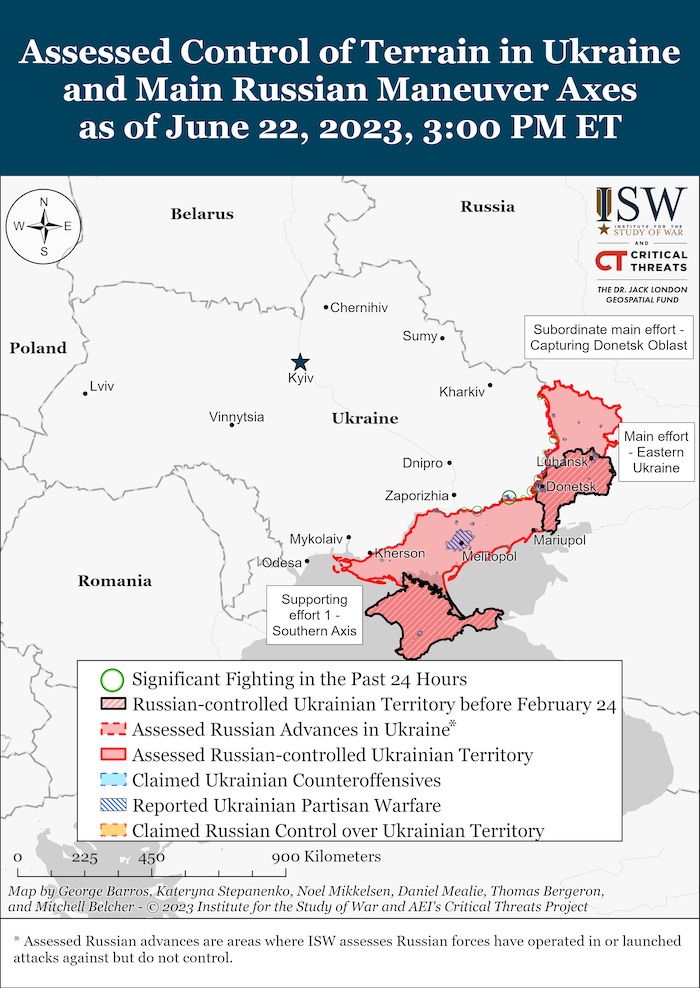
[The Russian Federation continues to kill Ukrainian people, and ignores the laws and customs of war, while using terror tactics, carrying out striking both military and civilian targets.]
Tonight, the Russian Federation launched another missile and air strike against Ukraine by Iranian attack UAV "Shahed". Information regarding the consequences of this terrorist attack is currently being clarified.
[On June 21, the enemy launched 6 Iranian strike UAVs "Shahed-136/131". All "Shaheds" were destroyed by Ukrainian Defence Forces.] During the past day, the enemy launched 44 missiles and air strikes. Also, the enemy launched 47 MLRS attacks. [Unfortunately, there are dead and injured civilians, and houses and other civilian infrastructure have been damaged.]
The threat of missile and air strikes across Ukraine remains high.
The enemy continues to focus its main efforts on the Lyman, Bakhmut, Avdiivka, and Mar’inka axes, and heavy battles continue. Over 40 combat clashes took place during the day.
- Volyn’ and Polissya axes: [no significant changes detected. There are no signs of the formation of enemy groupings. On the training grounds of the Republic of Belarus, combat training and coordination of units of the Russian armed forces are ongoing before they are sent to the frontlines in Ukraine.]
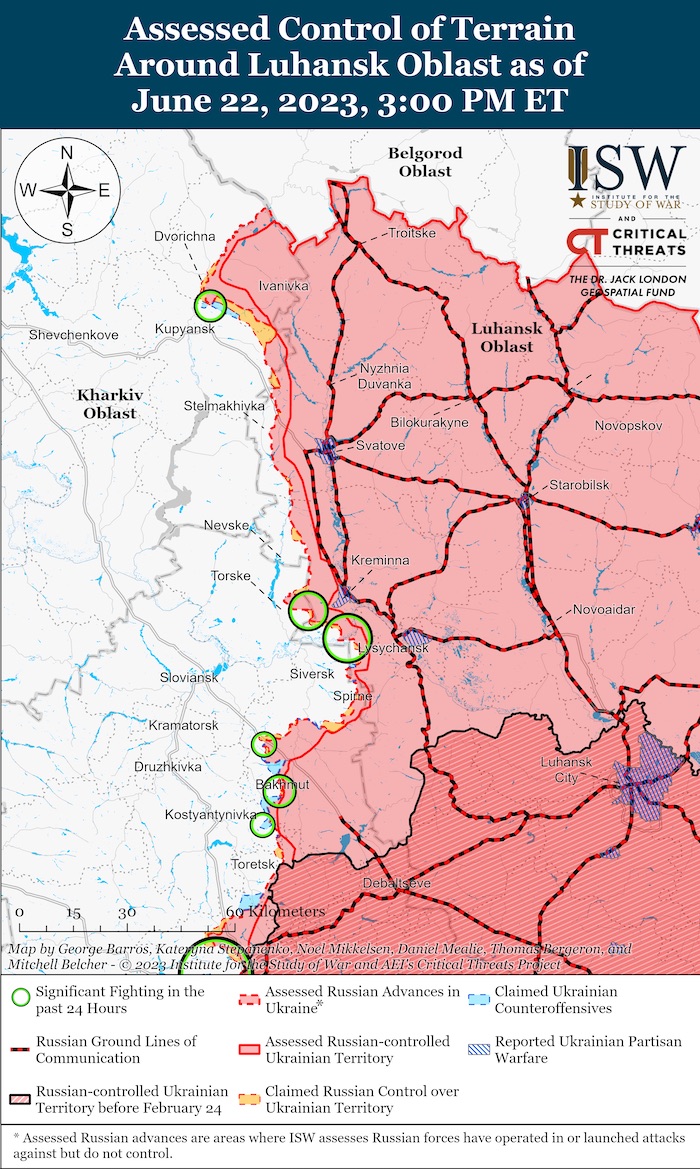
- Sivershchyna and Slobozhanshchyna axes: the enemy carried out airstrikes on the settlements of Leonivka and Mykolaivka of the Chernihiv region and Volfyna of the Sumy region. He carried out mortar and artillery attacks on the settlements of Hrinivka, Yeline, Karpovychi, Leonivka, Chernihiv region; Seredyna-Buda, Porokhon, Sytne, Fotofizh, Novi Virky, Volfine, Shpyl, Obody, Dmytrivka, Kindrativka, Loknya, Stepne, Velika Pisarivka of the Sumy region, as well as Odnorobivka, Udy, Veterinarne, Kozacha Lopan, Vysoka Yaruga, Lyptsi, Alisivka, Bugruvatka, Staritsa, Vovchansk, Vovchanski Khutory, Bochkove, Pletenivka, Mala Vovcha, Varvarivka, Budarky, Rublene, Aniskine, Milove in the Kharkiv region.
- Kupiansk axis: the enemy carried out an airstrike in the Sinkivka area of the Kharkiv region. Krasne Pershe, Figolivka, Novomlynsk, Dvorichna, Zapadne, Masyutivka, Kislivka and Berestov in the Kharkiv region were subjected to enemy artillery and mortar attacks.
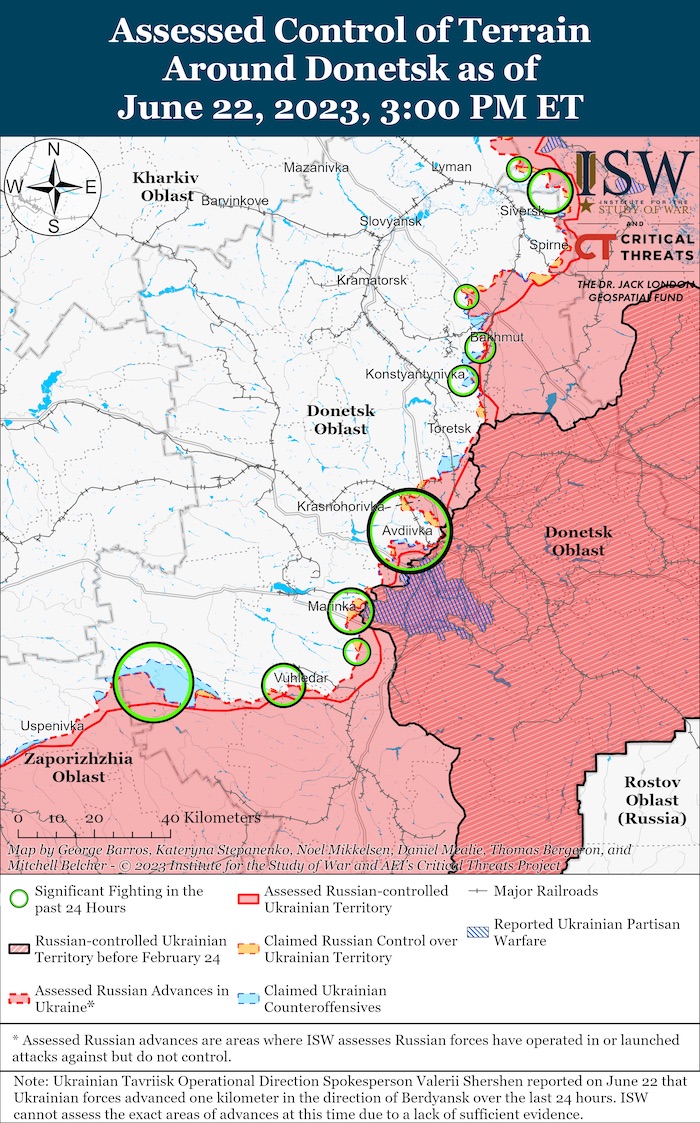
- Lyman axis: the enemy carried out unsuccessful offensive actions in the districts of Dibrova and Bilogorivka in the Luhansk region and Serebryanka in the Donetsk region. Carried out airstrikes near Novoyehorivka and Belogorivka in the Luhansk region and Siversk - Donetsk region. Stelmakhivka, Nevske, Dibrova, Kuzmine, Bilogorivka of the Luhansk region and Torske, Verkhnyokamianske, Spirne and Rozdolivka of the Donetsk region were hit by artillery fire.
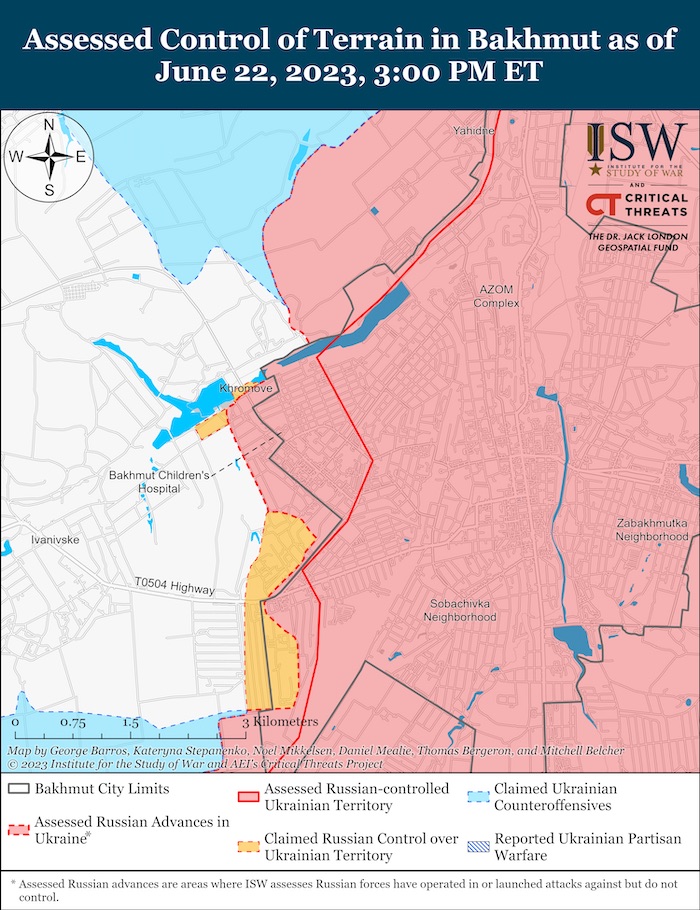
- Bakhmut axis: the enemy carried out unsuccessful offensive actions in the areas of Orihovo-Vasylivka, Ivanivskoye and Bila Hora. Carried out airstrikes near Druzhkivskyi, Kurdyumivka, and New York in the Donetsk region. Vasyukivka, Orikhovo-Vasylivka, Bohdanivka, Kalynivka, Chasiv Yar, Ivanivske, Ozaryanivka, Bila Gora, Kostiantynivka, Druzhba and Severny of the Donetsk region suffered from enemy artillery shelling.
- Avdiivka axis: the enemy carried out unsuccessful offensive actions in the Avdiivka, Severny and Pervomaisky regions of the Donetsk region. He carried out airstrikes near Avdiivka, Severny and Pervomaisky. He carried out artillery shelling of the areas of the settlements of Oleksandropil, Keramik, Novokalynove, Berdychi, Stepove, Avdiivka, Tonenke, Severna, Pervomaiske, Netaylove and Nevelske of the Donetsk region.
- Marinka axis: the enemy carried out offensive actions in the area of Mariinka, Pobyeda and Novomykhailivka of the Donetsk region, without success. Made an airstrike near Krasnohorivka. At the same time, he carried out artillery shelling of the settlements of Krasnohorivka, Zoryan, Gostre, Mariinka, Georgiivka, Kurakhove, and Pobyeda in the Donetsk region.
- Shakhtarske axis: the enemy carried out offensive actions in the areas of Novomykhailivka and Vugledar, without success. Airstrikes near Novomykhailivka and Zolotaya Niva. He shelled the settlements of Paraskoviivka, Novomykhailivka, Kostiantynivka, Elizavetivka, Katerynivka, Bogoyavlenka, Blagodatne, Prechistivka, Zolota Niva, and Velika Novosilka in the Donetsk region.
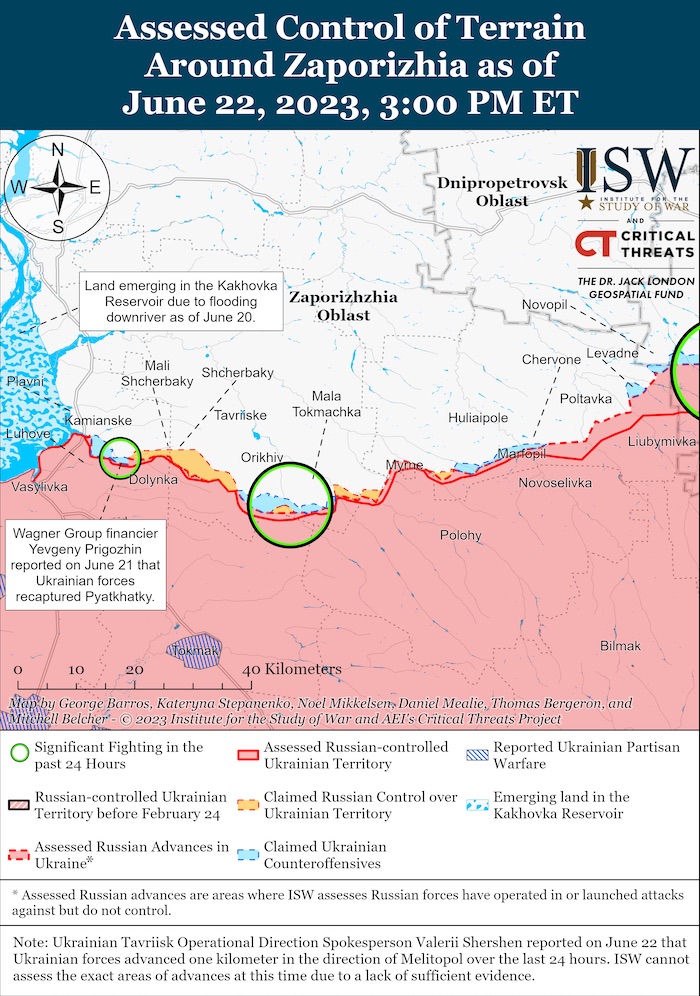
- Zaporizhzhia and Kherson axes: The enemy continues to conduct defensive Conducted unsuccessful offensive actions in the direction of Pyatikhatok, Zaporizhzhia region. The enemy carried out airstrikes in the Levadny, Preobrazhenka, Malaya Tokmachka, Novodanilivka, and Stepnohirsk districts of the Zaporizhzhia region. He carried out artillery shelling of the settlements of Novoocheretuvate, Neskuchne, Blagodatne, Makarivka, Storozheve, Zelene Pole, Temyrivka, Novopil, Burlatske of the Donetsk region; Levadne, Chervone, Gulyaipole, Novoandriivka, Stepove, Pyatikhatky, Lobkovo, Kamianske of the Zaporizhzhia region; Zolota Balka, Mykhailivka, Novooleksandrivka, Dudchany, Kachkarivka, Shlyakhove, Kozatske, Mykolaivka, Burgunka, Ivanivka, Sadove, Prydniprovske, Naddniprianske, Molodizhne, Zimivnyk, Bilozerka, Romashkove, Antonivka, Kherson, Dniprovske, Kizomys of the Kherson region and Ochakiv of the Mykolaiv region.
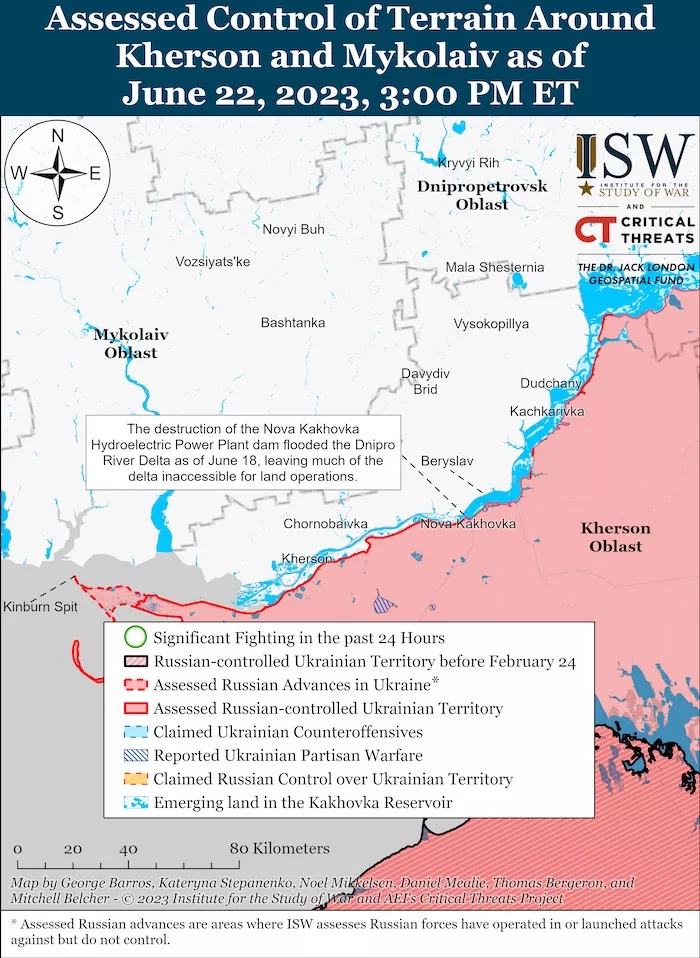
Over the past day, Ukrainian Air Force carried out 12 strikes on areas where enemy personnel are concentrated and 6 on enemy anti-aircraft missile systems. Our defenders also destroyed a Russian Mi-24 attack helicopter and 7 reconnaissance UAVs.
During the day, Ukrainian missile and artillery units hit 3 control points, 1 anti-aircraft missile complex, 2 areas of concentration of enemy personnel and military equipment, 13 artillery pieces in firing positions, 2 EW stations and an enemy ammunition depot.“
Explosions in Kryvyi Rih as Russian Tu-22 bombers strike from Sea of Azov area, Ukrinform reports. “Explosions rang out in the industrial hub of Kryvyi Rih after the Russian Tu-22M3 strategic bombers launched missiles from the area of the Sea of Azov. This was reported by Ukrinform with reference to the head of the city military administration, Oleksandr Vilkul, and a number of monitoring platforms.
Meanwhile, the Air Force Command reported the launch of Russia’s Kh-22 missiles in the direction of the Kirovohrad region from the waters of the Sea of Azov.”
Ukrainian forces gain significant ground on Tavriia front – Commander of Tavriia Group of Forces, Ukrainska Pravda reports, citing Brigadier General Oleksandr Tarnavskyi, Commander of the Tavriia Operational and Strategic Group of Forces. “Our army has been systematically driving the enemy out of their positions on the Tavriia front and advancing. The progress of the [Ukrainian] Defence Forces is noticeable. Units of [Ukraine’s] Rocket Forces and Artillery carried out 1,119 firing missions over the past 24 hours. The enemy's losses have amounted to almost three companies [with military personnel either] killed or wounded over the past 24 hours [three companies traditionally consist of roughly 300 soldiers – ed.]. Sixty-eight pieces of enemy military equipment were either destroyed or damaged.
Tarnavskyi listed Russian losses over the course of 24 hours: 6 tanks, 13 infantry fighting vehicles, 2 armoured combat vehicles, an MTLB multi-purpose fully amphibious auxiliary armoured tracked vehicle, 3 Supercam UAVs, an Orlan-10 UAV, five 2S19 Msta-S howitzers, four 2A65 Msta-B howitzers, 2 Strela anti-aircraft missile systems, five 2S5 Giatsint self-propelled artillery systems, two 2S3 Akatsiya self-propelled artillery systems, a 2S7 Pion self-propelled artillery system, BM-21 Grad multiple rocket launcher, and a Zoopark counter-battery radar system. Three Russian ammunition storage points were also destroyed.”
Military Updates
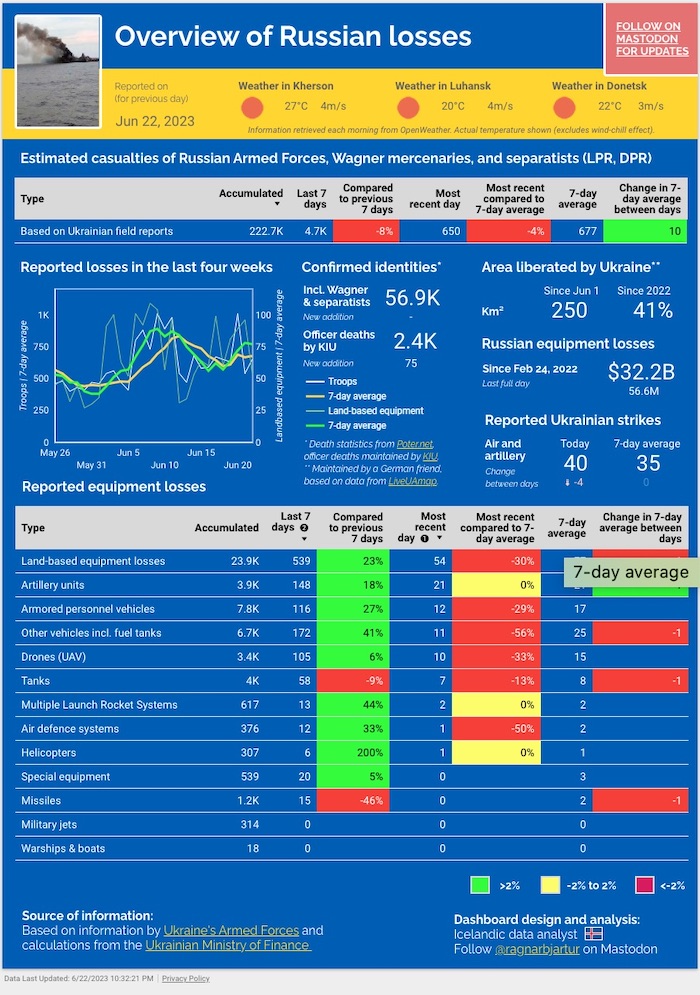
Ukraine offensive 'slower than desired', Zelenskyy says; Putin sees 'lull', Reuters reports. “President Volodymyr Zelenskyy was quoted on Wednesday as saying progress in Ukraine's counteroffensive against Russian forces was "slower than desired", but that Kyiv would not be pressured into speeding it up. […]
His adversary, Russian President Vladimir Putin, said Moscow had observed a "lull" in Ukraine's counteroffensive, which began early this month. Although Ukraine still had some offensive potential, Kyiv understood it had "no chance", Putin said in televised remarks.
Ukraine says it has reclaimed eight villages so far in its long-awaited counter-offensive, its first substantial gains on the battlefield for seven months. But Ukrainian forces so far have yet to push their way to the main defensive lines that Russia has had months to prepare. Kyiv is believed to have set aside 12 brigades of thousands of troops each, most of which have yet to join the fight. […]
The BBC quoted Zelenskyy as saying the military push was not going easily because 200,000 square km (77,220 square miles) of Ukrainian territory had been mined by Russian forces. […] After a flurry of early gains, Kyiv has claimed to have captured only one additional village over the past week, the hamlet of Pyatikhatky. Officials said on Wednesday forces in the south were mostly consolidating earlier gains, while troops in the east were holding off Russian attacks.”
Ukrainian Defenders name 2 reasons for intensification of Russian attacks on Lyman and Kupiansk fronts, Ukrainska Pravda reports. “The Russian occupation forces have intensified their assaults on the Lyman and Kupiansk fronts to draw the defenders' forces away from the supply route and reach the administrative border of Luhansk Oblast. In particular, according to sources in one of the National Guard of Ukraine units, in the afternoon of 20 June, Russians intensified their assault on Ukrainian positions on the Lyman front. Especially around Dibrova (12 km east of liberated Yampil) and Serebrianka Forest. One of the newly formed and not very well trained units of the Ukrainian Armed Forces had to retreat from a small part of its positions, the sources said.
At the same time, the Russians have been pressing along the entire line from Kupiansk to Lyman for the past few weeks. Some military officials suggest that this is how the Russians want to draw Ukrainian units advancing on the flanks on the Bakhmut front to this section of the frontline.
However, sources of Ukrainska Pravda claim that the motivation is somewhat different. Thus, the Russians are advancing on Kupiansk to move the contact line away from the road that goes through the occupied Troitske and Svatove and serves as their main supply route. And they are advancing on Lyman and surrounding settlements to recapture villages in Luhansk Oblast (Makiivka, Nevske, etc.) and to re-enter the administrative borders of Luhansk Oblast.”
Six Shaheds destroyed, the Ukrainian General Staff reports. “On the night of June 21, the enemy struck from the north with Iranian-made Shahed attack drones. All kamikaze drones were destroyed by the forces and means of the Air Force in Khmelnytskyi. Over the past day, June 20, the Defence Forces of Ukraine have landed 4 enemy reconnaissance drones of various types.”
According to British Defence Intelligence, (last 48 hours):
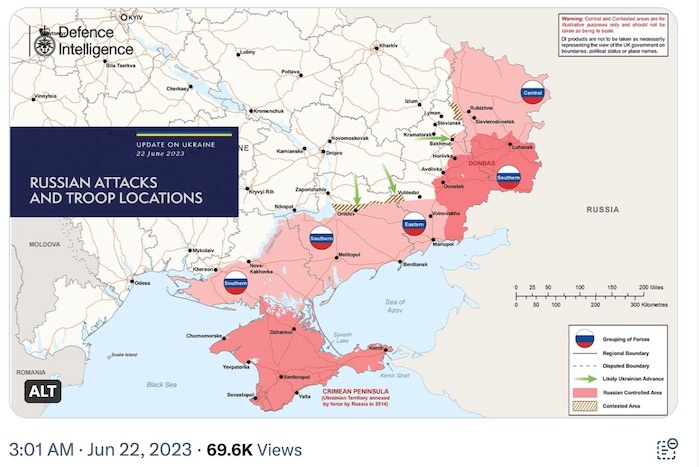
- On 20 June 2023, Russia’s Duma voted to create a parliamentary committee to investigate alleged crimes committed by the Ukrainian government against juveniles in the Donbas since 2014.
- The Duma is almost certainly responding to the international condemnation of Russia’s deportation of children from occupied Ukraine since its full-scale invasion.
- The move is highly likely both a form of ‘lawfare’ and contributes to Russian information operations, weaponising legislation by attempting to muddy the narrative around its own egregious actions. Messaging around children’s rights is likely an important communications theme for the Kremlin because alleged child deportations formed the basis of the International Criminal Court’s arrest warrant against President Putin issued in March 2023.
- Intense fighting continues in sectors of southern Ukraine. However, over recent weeks, Russia has continued to expend significant effort building defensive lines deep in rear areas, especially on the approaches to occupied Crimea.
- This includes an extensive zone of defences of 9 km in length, 3.5 km north of the town Armyansk, on the narrow bridge of land connecting Crimea to the Kherson region.
- These elaborate defences highlight the Russian command's assessment that Ukrainian forces are capable of directly assaulting Crimea.
- Russia continues to see maintaining control of the peninsula as a top political priority.
Losses of the Russian army
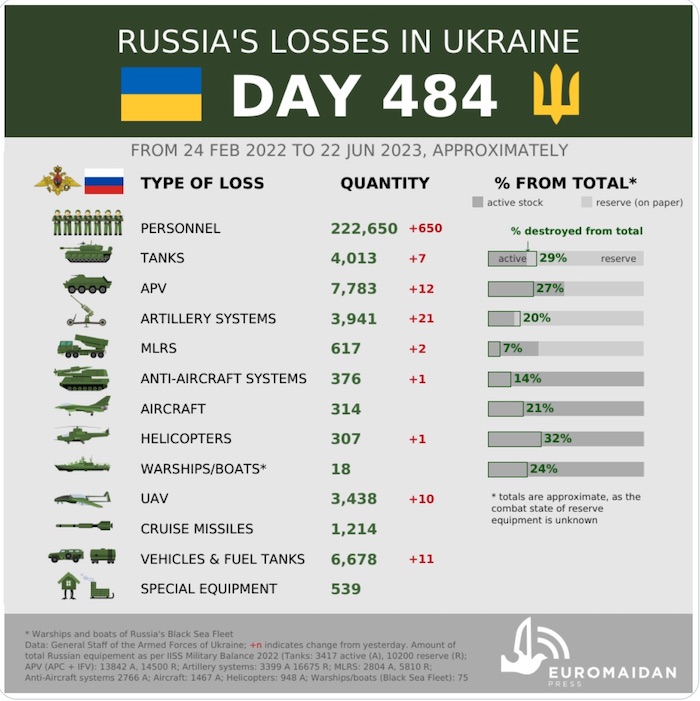
As of Thursday 22 June, the approximate losses of weapons and military equipment of the Russian Armed Forces from the beginning of the invasion to the present day:
- Personnel – about 222650 (+650)
- Tanks – 4013 (+7)
- Armoured combat vehicles – 7783 (+12)
- Artillery systems – 3941 (+21)
- Multiple rocket launchers –MLRS - 617 (+2)
- Air defence means – 376 (+1)
- Aircraft - 314 (+0)
- Helicopters - 307 (+1)
- Automotive technology and fuel tanks – 6678 (+11)
- Vessels/boats - 18 (+0)
- UAV operational and tactical level – 3438 (+10)
- Special equipment – 539 (+0)
- Mobile SRBM system – 4 (+0)
- Cruise missiles – 1214 (+0)
Humanitarian
Russians legalize filtration camps, prisons in temporarily occupied part of Donetsk region, Ukrinform reports, citing the mayor of Mariupol Petro Andriushchenko. "Gauleiter Pushilin issued an order to de facto create camps for the detention of all those who are not citizens of the so-called DNR or Russia, Andriushchenko said. The advisor to the mayor of Mariupol also drew attention to "readmit". He noted that in the case of the "DNR", no readmission is ever possible in principle. This means life-long detention in the camp.
The result is the trivial legalization of filtration camps and prisons. Which are a complete analogy of Nazi concentration camps. Except without gas chambers (although this is not certain)," Andriushchenko said. As Ukrinform reported, in April, the National Police recorded 27 filtration camps and prisons in the temporarily occupied territories of Ukraine.”
Environmental
IAEA says situation of ZNPP "extremely fragile", Ukrinform reports. “An IAEA update states that the explosion at the Kakhovka HPP and the subsequent breach of the downstream dam created an additional threat to the safe operation of plant, reports Ukrinform.
The nuclear safety and security situation at the Zaporizhzhia Nuclear Power Plant is extremely fragile. The loss of the Kakhovka reservoir was a catastrophe for the region as a whole and has also added to the severe difficulties for this major nuclear power plant. Now more than ever, all sides must fully adhere to the IAEA’s basic principles designed to prevent a nuclear accident. We will intensify our efforts to help ensure nuclear safety and security, while also providing assistance to the affected region in other ways, Director General Grossi said.”
Budanov: Russians mine cooler at ZNPP, Ukrinform reports, citing the Defense Intelligence of Ukraine (DIU) Kyrylo Budanov. “Answering the question whether there is a threat of an accident at ZNPP, he clarified that, unfortunately, there is a certain threat as of now. First of all, ZNPP was and still is under the temporary control of the occupation forces. The truth is that by destroying the dam, they destroyed the normal access of water to the coolers operating at ZNPP. Second, the plant was additionally mined. The worst thing is that it was the cooler that was mined, DIU's head said.
According to the head of military intelligence, if Russians disable the cooler by blowing it up, there is a high probability that there will be significant problems.
As reported, DIU said that Russia continues its nuclear blackmail tactics, using the occupied ZNPP and the territory of Belarus, where Russian nuclear weapons could be deployed.”
Occupiers' blowing up of Crimean Titan to affect three neighbouring countries, Ukrinform reports. “Ukraine is observing the activity of the Russian occupiers on the territory of the Crimean Titan plant and is recording the partial departure of the local population due to fears of a catastrophe. In the case of an explosion, the Russian military, who are closest to the plant, will be the first to suffer, and the accident may also affect citizens of Türkiye, Romania and Moldova, the head of the Joint Press Center of the Operational Command "South" Nataliia Humeniuk said.
We do not observe organized evacuations, but there are cases of group departures of people, and they are obvious in the sense of their own safety and concern for their own safety. That is, at their own discretion, many of the local population, taught by experience, in particular in 2018, when there were chemical emissions from this enterprise, people are trying to get away from this danger zone as much as possible, the spokeswoman said […].
Humeniuk emphasized that Ukraine is monitoring the activity of the occupiers in the area of the Crimean Titan, and noted that in case of its explosion, the Russian military will be the first to suffer. Yes, we are monitoring the situation regarding the delivery of explosives there, the activity of the occupation forces around, and it is likely that this will be another link in the chain of man-made blackmail used by the enemy. […]
In addition, she noted that unlike the explosion at the Kakhovka hydroelectric power plant, a terrorist attack on the Crimean enterprise will affect other countries. […] According to experts, the affected area may reach other countries, including Türkiye, Romania, and Moldova, and this should worry the leadership of these countries and increase international pressure, Humeniuk said.
As Ukrinform reported, the day before, […] National Security and Defense Council Secretary Oleksiy Danilov said that Crimean Titan and Zaporizhzhia NPP are key facilities where Russian occupation forces can strike, but this will not stop the process of liberating Ukraine from the enemy. Earlier it was reported that the invaders had taken valuable equipment from the Crimean Titan plant, and currently there is only one shop producing nitrogen fertilizers. Currently, 200 tons of ammonia are stored there.”
Occupiers cause damage to Ukrainian environment worth over €52B - Ministry of Environment, Ukrinform reports, citing Minister of Environmental Protection and Natural Resources of Ukraine Ruslan Strilets. "Unfortunately, there are things we will never restore. These are the ecosystems that were washed away into the Black Sea after the Kakhovka hydroelectric power plant explosion. These are 20,000 animals that potentially died. These are endemic species that were found only in the South of Ukraine. These are losses that cannot be estimated in monetary terms," Strilets said.
In his words, together with partner countries, Ukraine has developed unique methodologies for assessing environmental losses. For over a year of Russia's war, losses have already exceeded EUR 52 billion.”
Legal
Ukraine preparing mechanism to confiscate $500 billion of frozen Russian assets, Ukrainska Pravda reports. “The Ukrainian government is preparing a mechanism that would allow the confiscation of up to $500 billion of Russian assets frozen in the West. Ukrainian Prime Minister Denys Shmyhal announced during his speech at the Ukraine Recovery Conference in London that the confiscation of Russian assets should become the main source of funds for Ukraine's recovery, emphasising that Russia must pay for the destruction it caused. Shmyhal said, We are preparing a fair mechanism that will allow us to confiscate up to 500 billion dollars of Russian assets frozen in the West.
He reminded that the Council of Europe made a historic decision to establish a Register of damage caused by Russia's aggression against Ukraine. This is the first component of the International Compensation Mechanism.
Shmyhal mentioned that the second source of reconstruction funding would be the Ukrainian budget, including funds from confiscated Russian assets in Ukraine. The Ukrainian budget for 2023 has already earmarked $3.3 billion dollars. The third source is the assistance from Ukraine's international partners, including international financial organisations.
As previously reported, Denys Shmyhal, the Prime Minister of Ukraine, outlined the government's vision of using frozen Russian assets for the reconstruction of Ukraine and proposes a universal mechanism for the recovery of compensations from aggressor countries.”
Support
PM: Latvia sending its fleet of helicopters to Ukraine, Ukrinform reports, citing Prime Minister of Latvia Krišjānis Kariņš. “Latvia has already provided Ukraine with military aid alone amounting to more than 1% of its GDP, including the transfer of all available Stinger MANPADS, and is going to complete the transfer of all its helicopters.
At the beginning of his speech, he pointed out that Latvia never had any illusions about Russia, and therefore, against the background of Russia's build-up of troops near the Ukrainian border, in November-December 2021, a decision was made to send Stinger MANPADS to Ukraine. After receiving US approval for the supply of these American weapons, the Stingers arrived in Ukraine just one day before the full-scale invasion, and thankfully they became part of the solution of keeping the Russians from taking the airport which was part of their initial plan."
Germany Provides New Batch of Military Assistance to Ukraine, European Pravda reports. “Germany has provided Ukraine with including high-precision guided munitions. According to the German government, the new assistance package includes 155mm high-precision guided projectiles and a thousand 155mm artillery shells, two MAN HX81 8x8 wheeled trucks with trailers, and six border patrol vehicles.
In addition, an unspecified quantity of Patriot surface-to-air missile system rockets has been announced for delivery.”
Pentagon contracts $1.2B worth of AMRAAM missiles, including for Ukraine, Ukrinform reports, citing a Pentagon’s press release. “The US Department of Defense has signed a contract with Raytheon Missiles and Defense, ordering advanced medium-range air-to-air missiles (AMRAAM) for a total of $1.2 billion. The order is set to have been completed by January 31, 2027.
The contract involves unclassified Foreign Military Sales to Bahrain, Belgium, Bulgaria, Canada, Finland, Hungary, Italy, Japan, Netherlands, Norway, Qatar, Saudi Arabia, Singapore, South Korea, Spain, Switzerland, Ukraine, and the United Kingdom, which accounts for approximately 39% of the contract value.”
EU ambassadors support increase in funds they use to help Ukraine with weapons, Ukrainska Pravda reports, citing European Pravda. "Today, the EU Ambassadors approved an additional EUR 3.5 billion (2018 prices) to the European Peace Facility. This decision reaffirms the EU’s commitment to supporting its partners in the field of security and defence, Swedish Presidency of the Council of the EU posted on Twitter. Josep Borrell, High Representative of the European Union for Foreign Affairs and Security Policy added that the "vast majority" of the member states of the European Union support the proposal to increase the European Peace Facility.
European Peace Facility is an extra-budgetary instrument, the total volume of which is currently almost 8 billion euros. The EU member states are compensated from it for some of the military aid they transfer to Ukraine. In total, about EUR 4.6 billion has already been spent from the fund on military aid to Ukraine. […]
Earlier, Hungary blocked another EUR 500 million tranche from the European Peace Fund. The head of the Hungarian Ministry of Foreign Affairs, Péter Szijjártó, made it clear that it happened solely because of Ukraine's inclusion of the Hungarian OTP Bank in the list of international sponsors of the war.”
Ukraine attracts $51B in international aid since war started, Ukrinform reports, citing Minister of Finance of Ukraine Serhiy. "This year, we have raised $20 billion. Since the beginning of the war, we have managed to raise $51 billion, Marchenko said.
As reported, Ukraine expects to get $42 billion in financial assistance, including $4.6 billion from the International Monetary Fund, in 2023.”
Western nations commit billions to help rebuild Ukraine, Reuters reports. “Britain, the United States and the European Union pledged billions of dollars of extra help to rebuild Ukraine on Wednesday. Below are the details of some of the commitments made in connection with the Ukraine Recovery Conference in London.
The EU said on Tuesday it would provide Ukraine with 50 billion euros ($54.6 billion) in aid for 2024-27, of which 17 billion euros would come in free grants and the rest in the form of low-interest loans, it said.
US Secretary of State Antony Blinken pledged $1.3 billion of additional aid. He said $520 million was for overhauling Ukraine's energy grid, $657 million was for modernising its border crossings, ports, rail lines and other critical infrastructure, $100 million was to help digitise Ukraine's customs and other systems, while another $35 million would help businesses in the country with financing and insurance costs.
British Prime Minister Rishi Sunak outlined a package of support including loan guarantees worth $3 billion over three years. The country will also commit up to 250 million pounds ($318 million) of new capital for the British International Investment mechanism in Ukraine. There will also be an extra 240 million pounds of aid for Ukraine this year for humanitarian support, disaster relief kits, mine-clearance and energy projects.
French Foreign Minister Catherine Colonna said France would provide an additional 40 million euros ($44 million) to fund emergency reconstruction of critical infrastructure and health equipment.
German Foreign Minister Annalena Baerbock committed an extra 381 million euros for humanitarian assistance this year. For everything from generators to food, and tents for those who have fled or lost their homes recently, she said.”
World Bank and donors provide Ukraine with an additional $1.75B of financial support, Ukrinform reports, citing a press release published on the website of the World Bank. “The World Bank Group announced today $1.75 billion in additional support for Ukraine. The financing is composed of a $500 million World Bank loan guaranteed by the United Kingdom, a $1.25 billion grant from the United States, and a $15 million grant from the Government of Finland, the report says.
The support package is part of the World Bank’s Public Expenditures for Administrative Capacity Endurance in Ukraine (PEACE) Project, which helps Ukraine sustain critical service delivery capacity and core government functions at the national and regional levels. This additional financing for the PEACE project builds on previous funding and will continue to provide support in key sectors such as health care, education, payment of pensions, social assistance programs, and wages for employees providing core government services. […]
Since its inception in June 2022, the PEACE project has enabled the Government of Ukraine to sustain support for an estimated 13 million beneficiaries, including 10 million pensioners, 500,000 school employees, 145,000 government employees, 56,000 first responders, and over three million social assistance beneficiaries and internally displaced persons.
As reported, the PEACE project combines loans and grants from the World Bank and other development partners, and currently totals $19.745 billion. With today’s announcement the World Bank Group has now mobilized nearly $35 billion in emergency financing in support of the people of Ukraine, including commitments and pledges from donors including: the United States, Japan, the United Kingdom, Norway, the Netherlands, Spain, Germany, Canada, Switzerland, Sweden, Denmark, Austria, Finland, Ireland, Lithuania, Latvia, Iceland, and Belgium.”
New Developments
- Ukraine expects NATO membership invitation at summit - senior Kyiv official, Reuters “Ukraine expects to be invited to join NATO with an open date at the military alliance's summit in Vilnius next month, the Ukrainian president's chief of staff said on Wednesday. The official, Andriy Yermak, said the failure of the alliance to deliver a strong decision at the July 11-12 summit would demoralise Ukrainians and that Kyiv had demonstrated it was ready to join with its fighting on the battlefield. […] President Volodymyr Zelenskyy has pressed hard for Ukrainian membership of the military alliance, but also said he recognises it would be impossible to join while Russia's war in Ukraine is still raging.”
- Britain would be very supportive of plan that could simplify Ukraine's path to NATO – Cleverly, Ukrinform “The United Kingdom would be very supportive if Ukraine was able to go through a simplified process for joining NATO. The Guardianreported this with reference to the statement by UK Foreign Secretary James Cleverly. He noted that the UK would back suggestions Ukraine would not be required to go through the membership action plan (Map) stage of joining the military alliance. […] It is noted that if Ukraine effectively skipped this, it would put them in a category with new member Finland. […] I think the UK’s position would be very, very supportive if we moved on from the membership action plan recognising that the offer to both Sweden and Finland didn’t require that and Ukrainians have demonstrated their commitment to reform the military for requirement of NATO membership through their actions on the battlefield. And I think all NATO allies recognise that, the minister said.”
- Putin intimidates Ukraine and world with super-heavy ICBMs again, promising to deploy them on combat duty, Ukrainska Pravda reports, citing Kremlin-aligned news agencyTASS. “Russian dictator Vladimir Putin, boasting of the latest weapons in the Russian Armed Forces during a meeting with military graduates, has once again resorted to threats of putting new Sarmat launchers with a new super-heavy intercontinental ballistic missile (ICBM) on combat duty.[…] The head of the aggressor country bragged that the Russian Navy had commissioned the Borei-A project lead submarine, and the frigate Admiral of the Soviet Union's fleet Gorshkov went on combat duty in January 2023. He also said that the weapons of the Russian nuclear triad make it possible to effectively and reliably ensure strategic deterrence and maintain the global balance of power. Putin has claimed that about half of Russia’s Strategic Missile Forces units (SMFR) are equipped with the latest Yars thermonuclear ICBMs and that SMFR is allegedly being rearmed with modern missile systems with a hypersonic warhead called Avangard.”
- Zelenskyy on Putin's nuclear threats: He loves life, but has lost touch with reality, Ukrainska Pravda reports, citing the BBC. “President Volodymyr Zelenskyy believes that Russian President Vladimir Putin will not use nuclear weapons, but one cannot be sure about the country's leader, who has lost touch with reality. He will talk about using nuclear weapons, (but) I don't think he is ready for that because he is afraid for his life, he loves it too much. But I can't say for sure, especially about a man who has no ties to reality, who in the 21st century unleashed a full-scale war against his neighbour."
- Russian ally Belarus starts 'mobilisation exercises', Reuters “Belarus, an ally of Russia in the war with Ukraine, said on Wednesday that its armed forces were beginning 10 days of annual mobilisation exercises. The Belarus defence ministry said the exercises were aimed at assessing the degree of preparation of state institutions to mobilise reservists. All Belarusian men must perform military service, and remain in the reserves after completing it. Belarus allowed Russia to use it as one of the launchpads for its full-scale invasion of Ukraine last year. Since then, it has held frequent exercises with Russia and let Russian forces use its bases for training. This month it took delivery of Russian tactical nuclear missiles that President Vladimir Putin said were intended as a warning to the West. Belarusian forces have not directly joined the war on Russia's side, but President Aliaksandr Lukashenka has said his country would enter the conflict in the event of full-scale aggression against it.”
- EU Approves Eleventh Package of Sanctions against Russia, European Pravda "Today, the EU Ambassadors agreed on the 11th package of sanctions against Russia. The package includes measures aimed at countering sanctions circumvention and individual listings, tweeted the Swedish presidency of the Council of EU. Ursula von der Leyen, President of the European Commission, welcomed the political agreement on the 11th package of sanctions. It will deal a further blow to Putin’s war machine with tightened export restrictions, targeting entities supporting the Kremlin. Our anti-circumvention tool will prevent Russia from getting its hands on sanctioned goods, she tweeted. The European Commission presented proposals for the 11th package of sanctions against Russia to EU member states in early May. However, EU ambassadors struggled for weeks to reach a consensus. The main reason was Greece and Hungary protesting against including some of their companies on the list of "war sponsors" proposed by Ukraine. Athens and Budapest wanted their companies to be removed from that list.”
- China responds to Biden's "dictator Xi" statement, Ukrainska Pravda reports, citing Mao Ning, spokesperson of the Ministry of Foreign Affairs of China, cited by theBloomberg “At a briefing in Beijing on Wednesday, 21 June, Ning called Biden’s commentaries "irresponsible". It contradicts main facts and diplomatic protocols, seriously violates China’s political dignity and is a public political provocation, she stated. On Tuesday, 20 June, Biden stated at a charity event in California that Xi was astonished by a spy balloon, which flew over the US earlier this year, and claimed that he did not even know it was there. This is the biggest embarrassment for dictators – when they don’t know what happened, – Biden stated.”
- Kyiv Mayor claims "central government" is putting pressure on him, Ukrainska Pravda “Kyiv Mayor Vitalii Klitschko has said that the capital's administration, and Klitschko personally, are experiencing political pressure, and intimated that it was the "central government" that was exerting this pressure. There is a fierce campaign to discredit the Kyiv city government and me personally. Relentless searches paralyse the work of city [administration] departments and services. Chaos is being introduced into the capital’s wartime management, and critical infrastructure facilities are not able to keep up with their normal workload. The same documents are being requested again and again… They are trying their best to ruin Klitschko’s reputation, but they won’t be able to find anything against me, so they are handing suspicion notices to my subordinates and loudly accusing them of being guilty. But when those cases crumble in court, we won’t be offered any apologies. […] Someone wants to establish control over the capital once again. Have we already won [in the war against Russia]? Is Klitschko now [Ukraine’s] biggest problem?"
Assessment
- On the war.
The Institute for the Study of War has made the following assessment as of June 21, 2022:
Russian and Ukrainian forces continued to engage in positional battles on the Kupiansk-Svatove line on June 21. […] Russian Western Group of Forces Spokesperson Colonel Sergei Zybinsky claimed that artillery units of the 6th Combined Arms Army (Western Military District) struck Ukrainian troops near Vilshana (15km northeast of Kupiansk). A Russian milblogger claimed that positional battles continue in the Kupiansk direction but that Russian forces cannot break through to the city. A Russian milblogger claimed that Russian forces are pushing Ukrainian forces out of Synkivka and are establishing a foothold on the right bank of the Oskil River. A Russian milblogger claimed that Russian forces continue to outmanoeuvre Ukrainian forces west of the R66 Svatove-Kreminna highway.
Ukrainian forces continued counteroffensive operations near Kreminna on June 21. Ukrainian Deputy Defense Minister Hanna Maliar reported that Ukrainian forces conducted partially successful offensive operations in the Bilohorivka-Shypylivka direction (10km south of Kreminna) and have established themselves on newly captured frontlines. The Ukrainian General Staff also reported that Russian forces conducted unsuccessful offensive operations in the direction of Dibrova (5km southwest of Kreminna), Serebrianka (10km southwest of Kreminna), and the Kremmina-Yampolivka line (17km west of Kreminna). Geolocated combat footage posted on June 20 shows Ukrainian forces repelling a Russian armored assault east of Spirne (25km south of Kreminna). A Russian milblogger claimed that Ukrainian forces unsuccessfully attacked towards Kremmina and that Russian forces continued advancing in the direction of Torske (14km west of Kreminna) and the Oskil River west of Kreminna. A Kremlin-affiliated milblogger claimed that the intensity of fighting increased on June 20, and Russian airborne (VDV) units occupied several Ukrainian strongholds in the Serebrianske forest area (10km southwest of Kreminna). A Russian milblogger claimed that elements of Russia’s Central Group of Forces are conducting assault operations and repelling Ukrainian counterattacks in several areas near Kreminna. The Russian milblogger claimed that Russian forces destroyed two Ukrainian sabotage and reconnaissance groups attempting to advance from the Terny direction (17km west of Kreminna). The Russian milblogger claimed that Russian artillery units repelled a Ukrainian armored attack and forced a retreat near Dibrova and claimed that Russian artillery units repelled two Ukrainian attempts to break through Russian lines in the Serebrianske forest area. A Russian milblogger claimed that there is heavy fighting around Bilohorivka (12km southwest of Kreminna) in the Lyman direction.
Russian forces are constructing unknown military infrastructure in occupied Luhansk Oblast. Satellite imagery published on June 20 shows the construction of unspecified military infrastructure on military grounds of the Luhansk People’s Republic (LNR), southeast of the occupied city of Khrustalnyi.
Russian and Ukrainian forces continued limited ground attacks in the Bakhmut area on June 21. The Ukrainian General Staff reported that Russian forces conducted unsuccessful offensive actions near Orikhovo-Vasylivka (11km northwest of Bakhmut), Ivanivske (6km west of Bakhmut), and Bila Hora (16km southwest of Bakhmut). Ukrainian Deputy Defense Minister Hanna Maliar stated that several combat engagements occur in the Bakhmut area daily. The Ukrainian General Staff reported that Russian forces deployed elements of the 83rd Guards Airborne Assault (VDV) Brigade to the Klishchiivka (7km southwest of Bakhmut) area to replace elements of the 31st Guards VDV Brigade that recently suffered heavy losses. A Russian milblogger claimed that Russian forces conducted unsuccessful offensive operations near Hryhorivka (9km northwest of Bakhmut). […] Russian milbloggers claimed that Ukrainian forces conducted assaults north of Bakhmut near Yahidne (4km north of Bakhmut), Berkhivka (6km north of Bakhmut), and Orikhovo-Vasylivka and southwest of Bakhmut near Klishchiivka. One milblogger claimed that the tempo of Ukrainian ground assaults near Berkhivka is declining and that Ukrainian forces have temporarily paused assaults near Rozdolivka (19km north of Bakhmut) to regroup.
Russian and Ukrainian forces continued ground attacks along the Avdiivka-Donetsk City front on June 21. The Ukrainian General Staff reported that Russian forces conducted unsuccessful offensive actions near Avdiivka, Sieverne (6km west of Avdiivka), Pervomaiske (11km southwest of Avdiivka), Marinka (27km southwest of Avdiivka), and Novomykhailivka (36km southwest of Avdiivka). […] Geolocated footage published on June 21 indicates that Ukrainian forces are operating in northern parts of Marinka that Russian sources previously claimed that Russian forces controlled. A Russian milblogger claimed that Russian forces also conducted assaults near Pobieda (32km southwest of Avdiivka) and made unspecified gains in the area.
Russian forces conducted limited ground attacks in the Vuhledar area on June 21. The Ukrainian General Staff reported that Russian forces conducted unsuccessful offensive actions near Vuhledar.
Ukrainian forces conducted limited ground attacks along the administrative border between western Donetsk and eastern Zaporizhzhia oblasts on June 21. The Ukrainian General Staff reported that Ukrainian forces are conducting offensive operations along the Vilne Pole-Makarivka line (up to 7km south of Velyka Novosilka). Russian sources claimed that Ukrainian forces conducted unsuccessful offensive operations south, southwest, and southeast of Velyka Novosilka. Russian milbloggers claimed that Ukrainian forces are attacking Urozhaine (10km south of Velyka Novosilka), and Wagner Group financier Yevgeny Prigozhin claimed that Ukrainian forces have already liberated the settlement. ISW has not observed visual confirmation that Ukrainian forces have liberated Urozhaine. Geolocated footage published on June 21 purportedly shows elements of the 3rd Battalion of the 60th Separate Motorized Rifle Brigade (5th Combined Arms Army, Eastern Military District) operating near Makarivka (6km southeast of Velyka Novosilka) and the “Kaskad” Operational Combat Tactical Formation (a Donetsk People’s Republic formation) operating near Urozhaine. Footage published on June 21 purportedly shows the 40th Naval Infantry Brigade (Pacific Fleet) operating near Novodonetske (10km southeast of Velyka Novosilka).
Russian and Ukrainian forces conducted limited ground attacks in western Zaporizhzhia Oblast on June 21. The Ukrainian General Staff reported that Russian forces conducted unsuccessful offensive operations in the Pyatykhatky direction (25km southwest of Orikhiv). ISW geolocated footage published on June 21 that shows continued Ukrainian control of Pyatykhatky. Some Russian sources claimed that Russian forces control Pyatykhatky, and others Russian sources claimed that neither Russian nor Ukrainian forces control the settlement. A Russian milblogger claimed that Russian forces are attempting to recapture Pyatykhatky from positions in Zherebyanky (27km southwest of Orikhiv. The Ukrainian General Staff reported that Ukrainian forces are conducting offensive operations along the Novodanylivka-Robotyne (6km south of Orikhiv to 15km south of Orikhiv) and Mala Tokmachka-Verbove (9km southeast of Orikhiv to 20km southeast of Orikhiv) lines. Ukrainian Deputy Defense Minister Hanna Maliar reported that Ukrainian forces are continuing to conduct offensive operations in southern Ukraine with partial success, consolidating gained positions, and leveling the frontline. Prigozhin claimed that Ukrainian forces control Pyatykhatky and areas north of Robotyne (15km south of Orikhiv). Russian sources claimed that Ukrainian forces conducted offensive operations near Robotyne and Zherebyanky. Footage published on June 21 purportedly shows elements of the 292nd Self-Propelled Artillery Regiment and 429th Motorized Rifle Regiment (both of the 19th Motorized Rifle Division, 58th Combined Arms Army, Southern Military District) and the “Crimea” and “Sudoplatov” volunteer battalions operating near Pyatykhatky.
Russian sources claimed that Ukrainian forces conducted a missile strike against a Russian rear position in Zaporizhzhia Oblast. Russian sources claimed that Ukrainian forces conducted a HIMARS strike on Rozivka, about 65km northwest of Mariupol in eastern Zaporizhzhia Oblast.
Prigozhin claimed that Ukrainian forces are attempting to cross the Dnipro River in the Hola Prystan (12km southwest of Kherson City) area. ISW has not observed visual evidence to support his claim.
The UK Ministry of Defense (MoD) reported that Russian forces continue to construct defensive lines to protect occupied Crimea. The UK MoD reported that Russian forces have built a 9km-wide defensive zone about 3.5km north of Crimea. ISW has previously reported on Russian forces constructing defensive lines in northern Crimea and continues to assess that the construction of fortifications in Crimea may suggest that Russian forces are unsure of their ability to hold occupied territory in southern Ukraine.
Ukrainian forces conducted counteroffensive operations on at least three sectors of the front on June 21. Ukrainian Deputy Defense Minister Hanna Maliar stated on June 21 that Ukrainian troops had partial success during offensive operations in the Bilohorivka-Shypylivka direction (about 10km south of Kreminna in Luhansk Oblast). A Russian milblogger additionally claimed that Ukrainian forces are counterattacking in the areas south and west of Kreminna. The Ukrainian General Staff reported that Ukrainian forces continued offensive operations in the western Donetsk-eastern Zaporizhzhia Oblast border area on the Vilne Pole-Makarivka line, and Russian milbloggers continued to discuss Ukrainian attacks in this area, particularly south of Velyka Novosilka. Ukrainian and Russian sources reported that Ukrainian troops continued offensive operations in western Zaporizhzhia Oblast, both south and southwest of Orikhiv and that Russian forces are counterattacking to regain lost positions in this direction. Russian sources noted a relatively slower pace of Ukrainian offensive operations in both western Donetsk and western Zaporizhzhia oblasts compared to the previous days.
Ukrainian President Volodymyr Zelensky acknowledged that the progress of Ukrainian counteroffensives has been slower than expected, likely due to effective Russian defenses. Zelensky stated that Ukrainian counteroffensive progress has been “slower than desired” and will take time. Zelensky noted that Ukrainian advances are not easy because Russian forces have mined 200,000 square kilometers of frontline territory. Russian President Vladimir Putin also addressed ongoing Ukrainian counteroffensives and preposterously claimed that Russian forces have destroyed 244 tanks and 679 armored vehicles since these operations began on June 4. Russian forces’ doctrinally sound defense in western Zaporizhzhia Oblast and prepared defensive positions throughout southern Ukraine are likely slowing Ukrainian advances, as ISW has previously assessed. A Russian milblogger claimed that Russian defensive positions in southern Ukraine, dubbed the “Surovikin Line” after former overall theater commander Army General Sergei Surovikin, consist of several defensive zones between lines along dominant elevated positions up to 30km into Russian held territory. The milblogger claimed that the “Surovikin Line” consists of a forward line of defense with several dozen platoon and company strongholds, and a main defensive line roughly 25km back with minefields, anti-tank ditches, and other defensive structures in between, though the extent of these defenses along the entire front line is unclear. These Russian defensive lines are likely arrayed to enable a first echelon of Russian forces, deployed to the forward defensive line, to slow advancing Ukrainian forces while a second echelon of forces deployed closer to the main defensive line launch counterattacks against any Ukrainian breakthroughs, as well as providing prepared fallback positions for frontline Russian units. Localized Ukrainian territorial gains are unlikely to immediately disrupt these Russian defensive lines and localized Ukrainian attempts at rapid breakthroughs are less likely to degrade these lines than a wider concerted operational effort, one which may be focused on degrading Russian defenders and fixing reserves rather than the immediate liberation of territory.
The overall slower than expected pace of Ukrainian counteroffensive operations is not emblematic of Ukraine’s wider offensive potential, and Ukrainian forces are likely successfully setting conditions for a future main effort despite initial setbacks. Ukrainian officials have long signaled that the Ukrainian counteroffensive would be a series of gradual and sequential offensive actions and have more recently offered the observation that currently ongoing operations do not represent the main thrust of Ukraine’s counteroffensive planning. Ukrainian Deputy Defense Minister Hanna Maliar emphasized on June 20 that it is not useful to gauge the success of military actions based "solely by kilometers or the number of liberated settlements.” Maliar’s statement echoes Ukrainian President Volodymyr Zelensky’s observation that war is not a ”Hollywood movie” that will deliver immediate and tangible results.
The observation that current Ukrainian operations may have objectives that are not simply territorial is an important one. Ukrainian forces may be conducting several offensive operations across the entire theater in order to gradually attrit Russian forces and set conditions for a future main effort. Losses are inevitable on both sides, but careful operational planning on the Ukrainian side likely seeks to mitigate and balance this reality with the equally important observation that the degradation of Russian manpower is a valuable objective. Wagner Group Yevgeny Prigozhin voiced his concern that Russian forces are suffering major manpower and equipment losses as a result of ongoing Ukrainian attacks, especially in southern Ukraine. The success of Ukrainian counteroffensives should not be judged solely on day-to-day changes in control of terrain, as the wider operational intentions of Ukrainian attacks along the entire frontline may be premised on gradually degrading, exhausting, and expending Russian capabilities in preparation for additional offensive pushes.
Ukrainian defense industry conglomerate “Ukroboronprom” announced on June 20 that Ukraine built and successfully tested a 1,000km-range drone, indicating Ukraine’s intent and ability to target Russian military infrastructure in Russian-occupied territories and Russia with Ukrainian-made drones. Ukroboronprom Spokesperson Nataliya Sad stated that Ukrainian forces successfully used the new Ukrainian-made drone but did not provide information on whether this drone was already used for strikes. Ukroboronprom previously announced its development of the 1,000km range drone in October 2022. Ukrainian Main Military Intelligence Directorate (GUR) Head Kyrylo Budanov told The Economist that Ukraine is at war and that drones over the Kremlin show that Russian defenses are “Potemkin villages” - an expression referring to the purported construction of fake settlements by a historical Russian minister to hide the true state of the Empire from the Tsar. While Budanov did not confirm that the Ukrainian forces previously launched drones over the Kremlin on May 3, US intelligence officials previously assessed that the Ukrainian special military or intelligence units are behind a series of covert actions against Russian targets including the May 3 strike. ISW had previously incorrectly assessed the May 3 attack on the Kremlin may have been a Russian false flag. Ukraine’s focus on development of long-range drones alongside US intelligence indicates that Ukraine will likely continue to pursue Russian rear targets with Ukrainian-made drones. International law allows Ukrainian forces to strike legitimate targets even in Russian territory, especially targets from which Russian forces are launching attacks on Ukrainian civilian infrastructure.
Russian occupation authorities continue to codify legal mechanisms for forcible deportations from occupied areas of Ukraine. Donetsk People’s Republic (DNR) Head Denis Pushilin signed an order on June 20 that creates a working group to regulate and oversee the creation of “temporary detention facilities for foreign citizens and stateless persons” in occupied Donetsk Oblast and designates these individuals as subject to expulsion or deportation from territory considered to be Russian under Russian law. Russian President Vladimir Putin signed a decree on April 27 that presaged Pushilin’s order by defining those living in occupied areas who refuse to accept Russian passports as “foreign citizens and stateless persons currently residing in the Russian Federation.” The establishment of the new DNR working group essentially sets formal conditions for the DNR government to detain residents of occupied Donetsk Oblast who are classified as “foreign citizens and stateless persons” under the April 27 law and officially designate them as subject to deportation from occupied Donetsk Oblast. The working group will also likely serve as a coercive tool aimed at forcing residents of occupied areas to obtain Russian passports out of fear of arbitrary detention and potential deportation. ISW continues to assess that all lines of effort aimed at codifying and formalizing the deportation of Ukrainians may constitute a violation of the Geneva Convention on the Prevention and Punishment of the Crime of Genocide, as well as a potential deliberate ethnic cleansing campaign.
Key Takeaways
- Ukrainian forces conducted counteroffensive operations on at least three sectors of the front on June 21.
- Ukrainian President Volodymyr Zelensky acknowledged that the progress of Ukrainian counteroffensives has been slower than expected, likely due to effective Russian defenses.
- The overall slower than expected pace of Ukrainian counteroffensive operations is not emblematic of Ukraine’s wider offensive potential, and Ukrainian forces are likely successfully setting conditions for a future main effort despite initial setbacks.
- Ukrainian defense industry conglomerate “Ukroboronprom” announced on June 20 that Ukraine built and successfully tested a 1,000km-range drone, indicating Ukraine’s intent and ability to target Russian military infrastructure in Russian-occupied territories and Russia with Ukrainian-made drones.
- Russian occupation authorities continue to codify legal mechanisms for forcible deportations from occupied areas of Ukraine.
- Russan and Ukrainian forces continued to engage in positional battles along the Kupiansk-Svatove line.
- Ukrainian forces continued counteroffensive operations near Kreminna.
- Russian and Ukrainian forces continued limited ground attacks in the Bakhmut area and along the Avdiivka-Donetsk City line.
- Ukrainian forces conducted limited ground attacks along the administrative border between western Donetsk and eastern Zaporizhzhia oblasts.
- Russian and Ukrainian forces conducted limited ground attacks in western Zaporizhzhia Oblast.
- The Russian military command is reportedly forming a new Azov Naval District as part of the Russian Black Sea Fleet.
- The Russian State Duma passed a law in the third reading raising age limits for Russian contract personnel and officer, likely to keep personnel currently due to retire in the force.
- Russian occupation authorities continue to deport children from occupied Luhansk Oblast to Russia under the guise of medical necessity.“
Russia creates affiliate of Black Sea Fleet in Mariupol, Ukrainska Pravda reports, citing the press service of the National Resistance Center. “The Azov Naval District is being created in Mariupol as part of the Russian Black Sea Fleet. According to the National Resistance Center, the completion of organisational measures and partial relocation of the Black Sea Fleet is scheduled for 1 July. The Center reports that the invaders plan to equip the Azov Naval Forces at the expense of the naval composition of the Black Sea Fleet and the Caspian flotilla of the Russian Navy.
In total, the Azov Naval Forces will include eight warships and boats, as well as 16 support vessels. In particular, this includes small missile carriers Cyclone and Askold, which are being tested, as well as the Amur, which is still under construction, the sea minesweeper Kovrovets and other ships. The National Resistance Center reports that the three small missile carriers have a total volley of up to 24 Kalibr missiles.”
- Consequences and what to do?
German far-right to nominate chancellor candidate as support soars, Reuters reports. “The far-right Alternative for Germany said on Wednesday it intended to nominate a chancellor candidate for the first time for the 2025 election as it soars in the polls, a day after the domestic spy agency cautioned voters about backing the party. Founded a decade ago, the AfD has surged to second place in opinion polls due to voter worries about recession, migration and the transition to a carbon-neutral economy, political analysts say.
The anti-establishment party is also benefiting from voter distrust in Chancellor Olaf Scholz's awkward three-party coalition that has spent much of the past few months fighting publicly over how to deal with these crises. Support for the AfD is running at a record 19-20%, behind the opposition conservatives on 27-28% but ahead or on a par with Scholz's Social Democrats and well ahead of the two junior partners in his coalition. […]
That authorities are worried about the situation was highlighted on Tuesday, when the head of the domestic spy agency Thomas Haldenwang warned citizens that far-right extremism posed the biggest threat to German democracy and voters should bear this in mind before casting their ballot for the AfD.
Haldenwang said parts of the AfD membership had spread hate against minorities as well as disseminated anti-Semitic sentiment and pro-Russian narratives. The AfD did not response to a request for comment on his statement. The party, which is under domestic spy agency surveillance, denies accusations of extremism.”
Over 80% of Ukrainian consider themselves free people – Razumkov Centre, Ukrainska Pravda reports, citing an opinion poll by Razumkov Centre. “The share of Ukrainians who consider themselves free people has increased from 62% to 84% compared to 2021. Choosing what is more important between freedom or equality, 75% of respondents prefer freedom (in 2022 there were 71% of them, in 2020 — 64%).
But if people are asked to choose between freedom and security, then Ukrainians are more likely to choose security (54.5%, and 44% choose freedom). However, the choice in favour of security is now much smaller than it was in 2020, when 66% of Ukrainians preferred security (amidst a large-scale war in Ukraine, when the relevance of the security issue has increased enormously).
When it comes to choosing between freedom and prosperity, the number of Ukrainians choosing freedom is constantly growing. If in 2010 the shares of those who preferred freedom and those who preferred prosperity were approximately equal (respectively 32% and 30%), then in May 2023 the share of the former increased to 51%, and the share of the latter decreased to 23%.”
Most Ukrainians think it would be bad if Ukraine was governed by military, Ukrainska Pravda reports, citing Interfax-Ukraine news agency, citing a survey conducted by the Razumkov Centre’s Sociological Service on 23-31 May 2023 as part of the MATRA project funded by the Dutch Embassy in Ukraine. “The number of supporters of a "military regime" in Ukraine has grown since the beginning of the full-scale war with Russia, but the vast majority of Ukrainians still dislike the idea of having such a government.
The full-scale war has led to an increase in the share of respondents in Ukraine who consider a government ruled by the military, or a military regime, to be "rather good" or "very good" (up to 28% from 12% in 2017). However, the overwhelming majority (71%) of Ukrainians still consider a military regime to be a bad thing.
At the same time, 26% of respondents in Ukraine consider both the military regime and the democratic system to be good (91% of those who consider the system ruled by the military or military regime to be good also consider the democratic system to be good). In other words, the military regime appears to be mainly seen as a means of protecting democracy in the context of military confrontation with the aggressor.
Over the past six years, Ukrainians’ assessment of the level of democracy in the country’s governance has been increasing. The average score that reflects people’s perceptions of how democratically Ukraine is governed has increased from 3.8 in 2017 to 5.1 in 2020 and 6.2 in 2023 (on a 10-point scale, where 1 means "not at all democratic" and 10 means "absolutely democratic").
Compared to 2020, the share of Ukrainian citizens who believe that the political system does not allow them to influence government actions has decreased from 34% to 28%. At the same time, the total share of those who believe that the political system "definitely" or "sufficiently" allows people like them to influence the government’s actions has also decreased from 17% to 12%. In general, Ukrainians’ assessment of the extent to which they are able to influence the course of their own lives has not changed much over the past few years, remaining within the range of 5.8-6.2 points on a 10-point scale.”
Rapid development of Ukraine's military industry expected once war ends, Ukrainska Pravda reports. “Denys Shmyhal, Prime Minister of Ukraine, said that rapid development of the military industry is expected in the country once the war comes to its end. We have identified five key segments that will form the basis for the recovery and transformation of our economy, Shmyhal said.
Shmyhal noted great potential in the energy sector of Ukraine, gas production and storage, as well as in hydropower. Another important sector of the Ukrainian economy is the military industry. European and global defence companies are increasingly considering options for building new production facilities in Ukraine. After the war, we expect a great boost in the development of this sector in Ukraine, the Prime Minister added.
Shmyhal also said that after the war, the growth of agriculture could double. He also considers infrastructure to be another promising industry branch. IT. We have ambitions to become a digital hub in Europe. We offer IT companies some of the most favourable tax and regulatory conditions in the world. In general, we are telling the private sector that those who invest in Ukraine today will have extraordinary opportunities and prospects in the coming years, the Head of the Cabinet added.”
Hans Petter Midttun: “There are risks and costs to action. But they are far less than the long-range risks of comfortable inaction” (John F. Kenned)
It serves as a great summary of my previous argument that NATO's failure to act upon 15 years of Russian provocations and transgressions of international law, helped convince Russia that it could act with impunity. After nearly 15 years of Russian aggressions – including attacking Georgia in 2008 and Ukraine in 2014, as well as waging a hybrid war against the USA and Europe for years – the Alliance has concluded that “the Euro-Atlantic area is not at peace.
NATO could not even bring itself to acknowledge what the EU recognised in 2021 already: Its member states are exposed to a Russian Hybrid War.
On 12 June, I argued that the West has not yet made any fundamental changes to its strategy to counter Russia. It is still doing the same as we did during the first eight years, only at a bigger scale and scope.
Russia has become the most sanctioned country in the world. Admittingly, the sanctions come at high costs to the West. However, the US and Europe sanctioned Russia before the full-scale invasion as well. Just not at the same scale and scope as today.
For eight years the West sought a political solution to the war (while failing to acknowledge that the Minsk agreement could never possibly deliver peace). Despite its newfound resolve and the steady inflow of weapons and ammunition, the West is still seeking a political solution to the war.
More telling, despite peace being turned into a low-intensity war and later, a full-scale, horrific war, the West is still not willing to force Russia to withdraw from Ukraine.
Despite genocide, ecocide, the threat of nuclear disaster, war crimes, and massive destruction and suffering, military power is still not an alternative course of action. The West has still not started investing in security and defence. Defence industries as still not been mobilised. Stockpiles are still running low. It remains largely inactive.
The international community is not least, still governed by its fear of escalation and the risk of a confrontation with a nuclear power. Its acceptance of risks turned a low-intensity war into a full-scale war. Worse still, the war continues to escalate. After 24 February:
- The political warfare has intensified. The political landscape in the USA and Europe will - as in the 1930s – most likely be changed by political forces seeking to exploit the voters' frustration over the “tsunami of ripple effects” from the war. The war has resulted in reduced energy and food security, increased poverty and hunger, recession, inflation and increased costs of living; as well as the potential repercussions. We have already experienced shifts in the political landscape (France, Sweden, Italy, and lately, Germany) that are likely to spread as the broader confrontation continues.
- The energy war has increased in scale and scope. European energy policy has been reshaped away from its past dependency on Russian fossil fuel. While relatively mild weather avoided rationing over the 2022-23 winter in European countries, challenges remain in securing sufficient storage levels for the 2023-24 winter. Underwater cable pipelines and cables have been destroyed. Transatlantic internet cables are being threatened.
- The world is being held hostage as Russia has weaponised food. We are, consequently, facing an increase in poverty and global famine and potentially, increased extremism and terrorism globally.
- Russia’s nuclear rhetoric has become more belligerent as it is stationing tactical nuclear arms in Belarus. It has mined Zaporizhzhia Nuclear Power Plant. More crucially, it is waging war between Ukraine’s 15 nuclear reactors.
- Ukraine is being exposed to ecocide at an unprecedented scale and scope with regional repercussions. This includes – but is not limited to – the destruction of the Kakhovka dam, the destruction of fertile agricultural areas, 200,000 square km of minefields, deforesting and lately, the mining of the Crimean Titan plant.
The West is still accepting risks hoping that Russia – despite evidence of the contrary - will not do its worst. It is doing more of what it already was doing while hoping for different results.
Having failed to establish an effective strategy, the threats, and risks, however, have increased in scale and scope.
“I never worry about action, but only inaction.” (Winston Churchill).
In the aftermath of the destruction of the Kakhovka dam, the largest environmental catastrophe in Ukraine since Chornobyl, I had hoped for a shift in Western strategic messaging and signs of resolve. Unfortunately, none have been observed. The Western response has, on the contrary, been remarkable in its restraint.
Eastern Europe – the ones that know Russia the best and still remember occupation and oppression – remains committed to Ukraine’s fight for its independence and sovereignty and our common security. The rest – “Old NATO” – remain committed to a strategy that has not only failed to secure peace and stability but also failed to de-escalate when war became a reality.
NATO has proven itself unable to respond to the war in Europe. The fact that the “Ukraine Defence Contact Group” exists at all is evidence of its failure. For an Alliance designed to stop conflicts threatening its member states, coordination of the defence aid should have been an integrated part of its tasks. It is not. On the contrary, NATO has limited itself to non-military support only. The Alliance is highly divided and has stepped back from its past commitment raising concerns over its future relevance.
“The Russian Federation is the most significant and direct threat to Allies’ security and to peace and stability in the Euro-Atlantic area. It seeks to establish spheres of influence and direct control through coercion, subversion, aggression and annexation. It uses conventional, cyber and hybrid means against us and our partners. Its coercive military posture, rhetoric and proven willingness to use force to pursue its political goals undermine the rules-based international order.”
Still, NATO fails to confront the Russian threat. The world is watching as NATO deterrence is being undermined. Its failure to protect the international security architecture that is the basis for Western security, stability and prosperity, sends the wrong strategic message to the world.
“Action breeds confidence and courage. If you want to conquer fear, do not sit home and think about it. Go out and get busy.” (Dale Carnegie)

